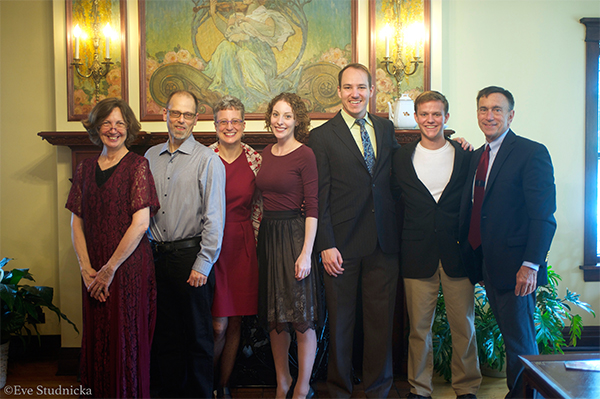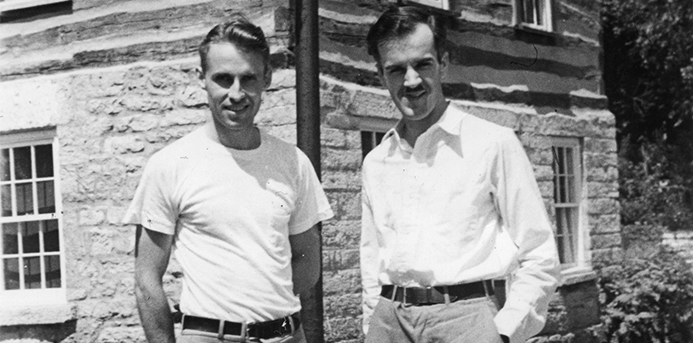Not every great love story is conventional.
Take, for instance, the story of Robert Neal and Edgar Hellum, who met and fell in love in the 1930s in Mineral Point, Wisconsin. They shared a passion for art and architecture — and each other, as it turns out. “Ten Dollar House,” the moving story of the life the couple built together, written by Martha Meyer and Rick Kinnebrew, graces the stage of Piccolo Theatre in Evanston during the month of January.
Neal, who was living in London and working with famed interior decorator Siri Maugham, wife of Somerset and creator of the famed “White Rooms,” was in Wisconsin visiting relatives when he heard that the Works Progress Administration (WPA) was bulldozing the old Cornish mining cottages. Of Cornish descent himself, he had long been fascinated with the old stone cottages and was determined to buy one. At the site, he met Hellum, who was harvesting stone, shutters and other salvageable items for his historic house in nearby Cooksville.
Partners for Life
Neal and Hellum became partners in both business and life. They purchased the home for just $10, named it “Pendarvis House” and turned it into a 20-seat restaurant serving Cornish food — and selling art and antiques — to serve the newly established automobile culture. A traveling salesman named Duncan Hines (yes, THAT Duncan Hines!) found them and included them in a publication he wrote telling of great places to eat on the road. After that, they were listed in the Saturday Evening Post as one of the Top Ten Best small restaurants to visit in the U.S. Visitors never guessed that the men were partners. Pendarvis House transformed the future of Mineral Point, making it a destination for food and art lovers, attracting artists to set up shop. Against all odds, they built a life together as their business thrived.
Librarians in Love
Another unconventional love story: Meyer and Kinnebrew met at the Evanston Public Library, where he served as the beloved children’s outreach librarian (your kids might know him as “Mr. Rick,” as he visited many schools with his guitar in hand) and she was a librarian assistant working on early childhood initiatives, including the popular kid’s program, “The Young and the Restless.” They fell for each other. “We were an inter-book romance,” laughs Meyer.
Meyer and Kinnebrew married in 2008, but couldn’t take time off during the busy school year. So it wasn’t until May 2009 that they finally took a budget honeymoon to southwestern Wisconsin, intending to see Frank Lloyd Wright’s Taliesin and visit the American Players Theatre in Spring Green.
But their visit to Taliesin was overshadowed by the recent publication of Nancy Horan’s “Loving Frank,” and the tour became more focused on the tawdry story of Wright’s affair with Mamah Borthwick than the architecture. To make matters worse, on stage at The American Players Theatre was “The Winter’s Tale,” Shakespeare’s devastating tale of adultery. Not surprisingly, they were looking for something a bit more romantic on their honeymoon.
Two Love Stories Collide
Meyer and Kinnebrew were tipped off to Mineral Point by an Evanston Public Library patron that they encountered at intermission. They discovered a lovely art community and then stumbled upon the historical recreation at Pendarvis House, where they learned about the Cornish miners. At the end of the tour, photos of Edgar Hullum and Bob Neal caught their eye, so they asked some questions. “I turned to Rick and said, ‘I think we’ve found a love story here,’ ” says Meyer.
Together, Meyer and Kinnebrew worked on a screenplay about the life and love of “Bob and Edgar,” as they are known in Mineral Point. “It takes a lot of money to make a film, and there are still people interested in that,” says Meyer. “We determined that the only way to get a groundswell of people interested in making this into a film was to turn it into theater, and we were amazed at how well it played.”
A staged reading of the screenplay was put on at Piven Theatre in early 2013, and then at the Mineral Point Opera House that summer. A partnership was forged with David Zak of Pride Films and Plays, an organization in Chicago dedicated to the celebration, creation and support of new LGBTQ work. A stage play was commissioned, and the work made it in front of the Artistic Director of Madison’s Broom Street Theater, where it played for four weekends to great audiences, though on a shoestring budget.

From that springboard, grant funding was lined up through the Arch and Bruce Brown Foundation, which helps fund LGBTQ-centric productions, and the Evanston Arts Council (EAC), which strengthens Evanston arts organizations. (Evanston’s Piccolo Theatre was rented for the January 2016 performances, which the EAC grant helped fund.)
Working Together
Writing “Ten Dollar House” together strengthened Meyer and Kinnebrew’s relationship. “It’s been fabulous,” says Meyer. “And obviously, it’s about us, at least for me. We wanted to write about a love story, which doesn’t come naturally to Rick, who usually writes brutal comedy. But it was something we wanted to tackle because we were in love with each other, a way to share emotions and ideas. We both love history and care deeply about LGBTQ issues.”
The couple feels strongly that now that marriage equality is the law of the land, our country needs stories about successful gay relationships. “It’s desperately important to see healthy gay relationships going through the normal stresses that we all do,” shares Meyer, “because love is love. And it’s important for young people to see that there was gay history before Stonewall. There’s beautiful history that needs to be uncovered and shared.”
If you’d like to attend the production of “Ten Dollar House” at Piccolo Theatre (600 Main St., Evanston), there are performances every weekend in January; Thursday, Friday and Saturday at 8 p.m. and Sunday at 3 p.m. Tickets can be purchased here.
If you’d like to help fund the play — as of today, they are about $600 shy of their goal — visit their Indiegogo donation page, open through Jan. 4.
More from Make It Better:

